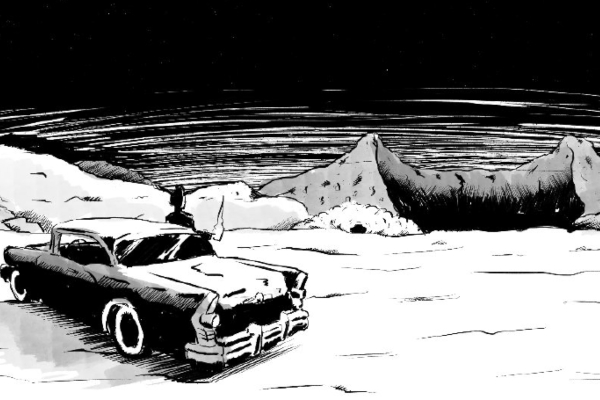On The Grave‘s Kickstarter page, creator David Taylor hooks potential backers in by comparing the comic to the likes of Frank Miller, John Wick and The Punisher. Its cover image for the accompanying video depicts a visually warped depiction of a twisted hand stretching out from a hole in the ground, the comic’s protagonist gazing down in hatred. The Grave is a comic that wears its influences on its sleeve as proudly as it depicts its hyper-violent, grim-thriller motifs from cover to cover. However, what’s most striking about The Grave is how unexpectedly sensitive it is.
The Grave features a romance that slow-burns in the story’s background, rather than forcefully bolted on in an effort to counterbalance the violent nature of the story. There’s gay and black crime lords at work, who play an integral role in making an otherwise straight-forward revenge story out of the action-thriller playbook a more complicated and engaging affair. Taylor’s artwork functions on a totally different level to the story and characters, however. The Grave‘s visuals bear an engulfing cinematic scope to it. At odds with the intimate, character-driven nature of the story, the two are unified via a bristling black and white palette. The Grave‘s secret weapon is how there’s a lot more going on in this comic than meets the eye.
If The Grave cherry-picks at any one piece of media, it’s undoubtedly John Wick. The story follows a nameless, out-of-town drifter of a protagonist becoming caught up in the operations of a sadistic yet small-time crime boss, O’Hare, who dreams of sinking his bigoted teeth into bigger things. An attempted murder to keep our nameless hero quiet is where the John Wick influences become most apparent, as he picks himself up, dusts himself down, and sets out on a mission of revenge. As his mission takes shape, the aforementioned crime lords is where The Grave truly flourishes. The progressiveness on Taylor’s part to have a gay man and a black woman acts as the bosses of O’Hare is a thoroughly welcome touch, but the twist in the tale runs deeper, as loyalties to right and wrong and individual morals become as entangled as our nameless vigilante.
At times, The Grave does succumb to the occasional dash of melodrama. The characters talk a great deal in metaphors, to the point where one starts to wonder if everyone in the town of Denton carries a thesaurus as much as they carry guns. However, what exploits that melodrama further is Taylor’s riveting art. He gives that melodrama a sense of purpose and clarity with intense shadows, illuminated in blade-like lines and explosive action-sequences. Elsewhere, the story also falls prey to jumbled resolutions in its characters. The Grave packs in additional themes of corrupt policemen and domestic abusers, one particular character falls under both categories. For a comic drenched in its morals, it leaves a bitter aftertaste in how this character eventually receives an immensely flat comeuppance.
Still, The Grave is a violent comic that preaches a non-violent message. It’s far more layered than its initial appearance might have you believe, which heightens its quality to enjoyably extremes. Even when the story becomes occasionally unbalanced, the artwork never fails to release you from its vice-like grip. Half-caught in a sort of stunned, permanent sense of midnight, it’s a comic that looks the part in every way. The Grave isn’t absolutely perfect, but much like its nameless protagonist, it leaves with its morals relatively intact.
Have you backed The Grave on Kickstarter yet? Let us know in the comments section below or send us a Tweet!




[…] Read up on our review of The Grave here. […]